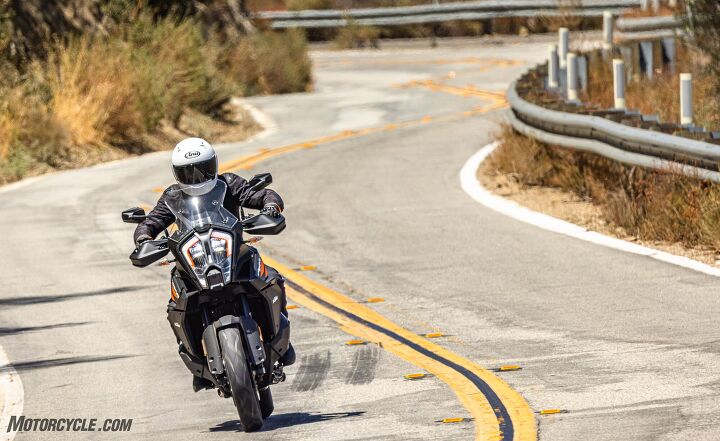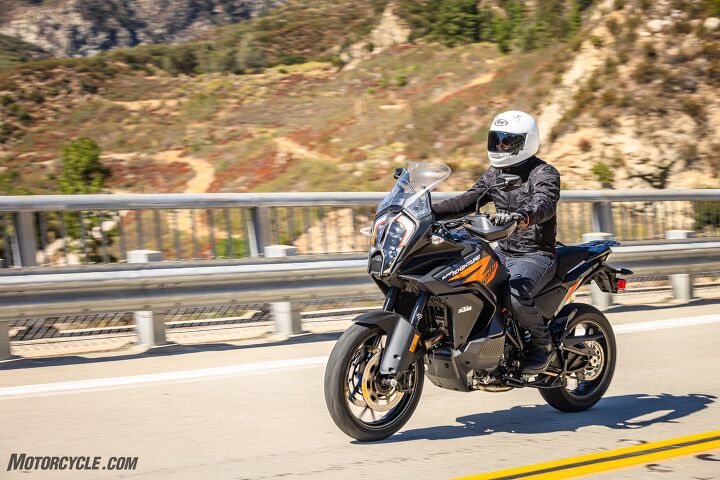Motorsports Racing News & Blog Articles
2022 KTM 1290 Super Adventure S Mini Review
If there’s one thing KTM knows how to do, it’s how to get dirty. The company obviously has its long history of off-road competition, and victories, to its name, and that success has transferred nicely into the adventure bike market. You can even argue KTM’s adventure bikes (along with the BMW GS family) are responsible for this boom in the ADV market.
2022 KTM 1290 Super Adventure SEditor Score: 88%
| Engine | 19.5/20 | Suspension | 14.5/15 | Transmission | 9/10 |
| Brakes | 9/10 | Instruments | 5/5 | Ergonomics | 8.5/10 |
| Appearance | 8.5/10 | Desirability | 7/10 | Value | 7/10 |
| + Highs An absolute beast of an engine Electronic suspension might be the most sophisticated I’ve tried yet Adaptive cruise control! | – Sighs It’s tall It’s heavy I’m not sure who would get this over the R model |
Considering that popularity in the category, KTM’s overhaul of the 1290 Super Adventure family made sense. On one hand, it was due for a refresh anyway, and on another hand, maybe this was KTM’s way of reminding everyone caught up in the middleweight ADV craze that big bikes have an undeniable flex the middleweights never will. In his review of the 1290 Super Adventure R, KTM’s big, burly, world-conquering adventure bike, RAdams gave praise to the bike, agreeing with KTM’s self-labeling of the SA-R as The Beast.
2022 KTM 1290 Super Adventure R Review
If you haven’t already, I suggest reading Ryan’s review of the R model to get up to speed on everything KTM changed. It’s quite a laundry list of changes, but a basic overview consists of a new frame, updated styling to match the 890 Adventure, including the low-slung jugs on each side of the bike that make up the 6.1-gallon fuel tank. The engine’s been lightened and moved around (but with no internal changes) and the swingarm is a little longer, too. All in the name of better handling.

Unsurprisingly, the 1290 Super Adventure S doesn’t differ much, visually, from the Super Adventure R. From this angle the obvious difference is the cast wheels on the S versus the wire-spoke wheels on the R. Note how low the fuel cell drapes – basically beside the cylinders!
Rounding out the changes are two radiators replacing the single piece on the old bike, a huge 7-inch TFT display to show everything you possibly need to know about the bike, and a myriad of electronic rider aids to help protect you from yourself. Thanks to the six-axis IMU on board, you now have lean-sensitive traction control, ABS, and cornering lights. Apart from the IMU, you also have a slew of ride modes (Street, Sport, Rain, Offroad, Rally).
The reality is that the R and S models are nearly identical motorcycles. What sets the S model apart from the R are the cast wheels (with Mitas Terra-Force R tires developed specifically for this bike), WP electronic suspension, and the radar-enabled adaptive cruise control (the R model only has standard cruise control). What we have here is KTM trying to maximize the same basic platform to reach two kinds of riders – the R model targeting adventure riders who tour, while the S model is for touring riders looking for adventure.
Does the S Model Deliver?
Well, yes. On paper, it’s hard to go wrong with the package the Super Adventure S brings to the table. Rolling down the road, the big 1301cc V-Twin has gargantuan power on tap from the moment you twist the grip. No surprise there. However, the initial Street ride mode the bike was set to would have a tiny delay in power delivery between when I moved my wrist to when power would touch the ground. With 96.2 lb-ft of torque on tap (at least when we dyno’d the R model), it’s understandable that KTM electronically softens power delivery in Street mode. After switching to Sport mode (which you can do on the fly), throttle pickup was much more direct. Some, like Ryan in his R review, would even say it borders on twitchy. While he’s not wrong, I preferred to have that direct feel for the power over the slight lag in Street mode. Eventually, you learn to anticipate the tiny lurch and ride accordingly. (Full disclosure: I didn’t try Rain mode. It’s the middle of summer here in Los Angeles, and there’s not a drop of water to be found).

KTM can partially hide the 1301cc V-Twin behind body panels, but once you’re romping down the road, the monster engine steals the show.
At this point, I won’t go on about the Super Adventure’s power. Anyone even remotely interested in this bike, or knowledgeable about the big engine, knows what a monster it is. Instead, let’s turn our attention to other things. Specifically, let’s look at the features separating the S from the R, the bevy of features the SA-S comes loaded with, and the intangibles that define every bike. At the end we’ll put them all together and decide whether it all combines to make a worthy touring bike.
First Up: The Cast Wheels
With pavement pounding being the primary duty of the Super Adventure S, it’s no surprise to see cast wheels in place of the wire-spoke wheels of the R model. The 19/17-inch front/rear combo is an interesting choice made even more peculiar with the choice of tire – the Terra-Force R from Mitas, a fringe brand not generally spoken about in the same breath as the likes of Pirelli, Michelin, Bridgestone, and others.
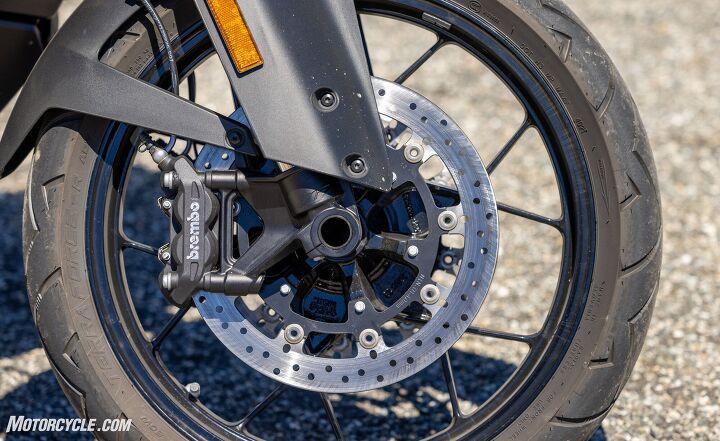
The 320mm brake rotors and Brembo calipers are shared between the S and R models and work well, as expected. Lean-sensitive ABS is a big safety benefit, too. It’s odd to see Mitas tires here, but there’s not much to complain about from them.
For their part, the Mitas tires never left me feeling wanting for more grip. That’s because the 19-inch front wheel is a constant reminder of what this bike isn’t – a Super Duke R. The natural product of a larger wheel is slower turning. Constant and considerable countersteering is in order to put the bike where you want to go. Combined with the slightly longer wheelbase compared to the previous Super Adventure model, this SA-S is certainly not a scalpel. With those kinds of steering characteristics, it prefers flowing curves over tight switchbacks, and a riding style to go with it. Smooth and steady wins the day on the SA-S, and that kind of riding doesn’t stress the limits of pavement traction. Then, of course, if an occasional easy dirt detour is in order, the bike can handle that, too.
Which brings us to the next item.
Electronic Suspension
More than anything else, the WP electronic suspension is the biggest difference between the S and R models. Its inclusion for the road-oriented model makes complete sense, too. More often than not I found myself riding in Auto mode which, as the name suggests, adjusts damping automatically based on the conditions. Unlike some other bikes I’ve ridden in the past with electronic suspension, you can really feel the WP system working underneath you.
During casual street riding or cruising down the highway, you can’t help but notice the fork and shock take a bump, move through its stroke, then rebound back up before settling back out again. Comfort mode really makes an emphasis on its namesake that way. While it’s a little weird to feel the suspension react to the road conditions so “slowly” (for lack of a better term), the resulting ride does feel comfortable. Bumping it out of Auto and into Sport damping as I got into the curvier sections of our ride simply resulted in the same feel of suspension action occurring… just faster. There’s no getting away from the fact the SA-S has long-travel suspension. It then becomes a matter of how fast or slow it goes through its travel and returns to normal.

When you’re cruising, the Auto suspension setting is nice and soft. Once the road gets twisty you can feel it firm up.
Despite this, if you’re really determined to dial-in the suspension action to your particular liking, it’s remarkably easy to dive into the Suspension menu screen on the huge TFT display. Here you can electronically adjust shock preload, anti-dive, and firmness for the fork and shock (WP decided not to use the traditional lingo of compression or rebound/tension, presumably worried it might scare people away). While I definitely appreciate the ability to fine-tune the suspension settings, it would have to take a very particular rider to feel the need to go through all that trouble – I thought the pre-programmed settings work pretty darn well for most situations.
Adaptive Cruise Control
For most of us, getting to the good roads means slogging it through the bad or boring ones. Cruise control is great and all, but adaptive cruise control really brings the game to another level. I know it sounds silly to be singing the praises of this technology – but does it? John Burns consistently knocks points off bikes without basic cruise control, and now we’re at a point where the rest of us have found ourselves following suit.
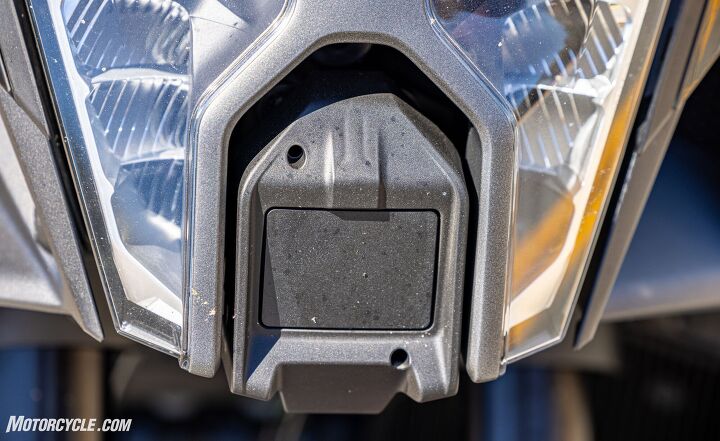
The ACC magic mostly lies in here. Maybe someday, as the tech evolves, the module will be small enough to be concealed more discreetly.
Not only is ACC a game changer, but it downright makes sense for a bike like this. If you’re going to be slogging lots of miles, let the bike do the work for the boring ones. KTM cleverly redesigned the headlights to make space for the radar system, and while you can clearly tell there’s a square in the middle of the headlight, it doesn’t detract from the overall look. More importantly, it works.
There’s a dedicated cruise control button on the left switchgear. Pressing it turns the system on. Tapping the thumb paddle sets your speed, while tapping it again increases it. Another paddle for your index finger brings your speed down. Adjusting the following distance is all done in the menu screen, and there are two choices to pick from: Sport and Comfort. Within those you can narrow down again how close or far you want to be from the vehicle in front of you.

It might look complex, but the buttons and toggles don’t need to be scary. You set the cruise control with the very top button, and the thumb/finger paddles on the bottom adjust your speed.
If you’ve driven a car with ACC then you know how it works. You set your speed and the bike will maintain that speed until something in front of you in your lane gets too close to your set parameters. Then the bike will slow to maintain the gap. The Bosch system on the KTM does the same. I set my following distance on the conservative side to give myself time to react in case an errant car driver in front of me did something stupid.
To really test the system, however, I ended up being the one to move behind cars to see how the system reacts. Initially, the KTM will ease off the throttle to maintain a gap, but if the closing speeds are dramatic then brakes will be applied, too. I really couldn’t get the ACC to do anything out of the ordinary, nor did I want to play the real life version of Frogger for too long. But what you need to know is it works, and it works well.
But I’m Still Confused
Ostensibly, there’s lots to like about the Super Adventure S. There’s a fire cracker of an engine, sophisticated electronics that are actually easy to use, suspension that caters to nearly every riding scenario, comfortable ergonomics to tackle all-day rides, and a 6.1-gallon fuel tank to get you wherever you’re going with minimal fuel stops.
So what’s not to like?
The intangibles. There’s no getting around the fact this bike is big and heavy. Coming in at around 540 lbs with six gallons of gas, that number doesn’t sound too bad for a touring bike. But with the bulk of that weight sitting in those low-slung tanks, picking the bike up off the sidestand requires a really good huck (luckily there’s also a centerstand). Things get even more challenging for short people. Standing 5-foot, 8-inches with a 30-inch inseam, I found it was a delicate balance to pick the bike up off the stand, plant the other foot on the ground, then kick the stand back up to its resting position.
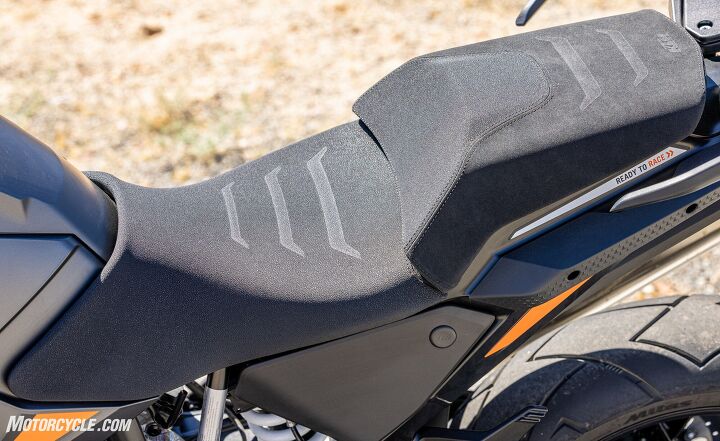
The adjustable seat height is nice, but it’s still tall and wide. The button on the side panel beneath the seat pops it open.
Putting feet on the ground naturally becomes the next obstacle. At its low setting of 33.4 inches off the ground, the KTM’s seat height already skews kinda tall. This is made worse by the fact the junction between the seat and fuel tank is rather wide. Getting both feet on the ground was impossible. I’d have to toggle between one foot and the other. If you’re blessed with long legs and an NBA player’s height, moving the seat (removable with a push button when the ignition is on) into different slots can raise the seat height to 34.2 inches.
Combine this heft and height, and I have a hard time coming to grips with riding the Super Adventure S with a passenger on back (nevermind the fact it doesn’t come with luggage…). For destroying dirt and roads unpaved, Ryan confirmed this platform is more than up to the task. But on the road, it’s heavy, tall, and steers a little slow. But hey, at least it has Hill Hold Assist.
Then there are the electronics. Street and Sport ride modes work great for their purpose (I assume Rain does as well), the electronic suspension could be one of the most sophisticated systems I’ve tried so far, ACC is awesome, and lean-sensitive TC and ABS are obvious benefits – but what’s the point of the Offroad and Enduro settings for a road-biased bike like this with (mostly) road-biased tires? John Burns says that’s exactly the point: “having good electronics means the street-biased tires won’t be as big of a problem offroad.” Still, I think if gobbling miles and hitting the dusty trail is your thing, the R is a much better option to do it on.
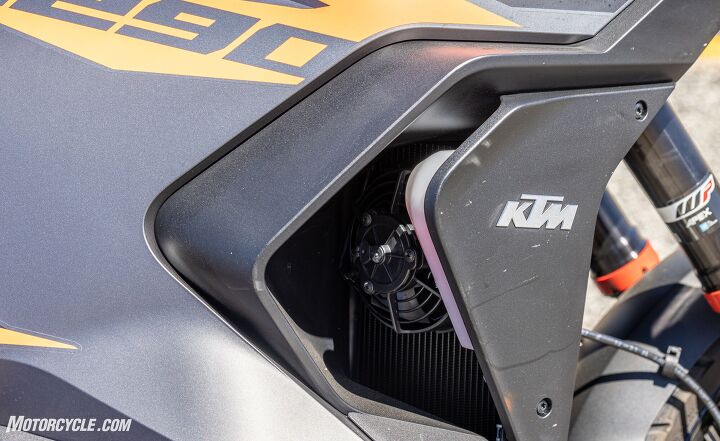
KTM switched from a single radiator to two, and this clever ducting pulls the hot air away from the rider.
Can you see why I’m confused now? There’s a lot going for the Super Adventure platform, but the S model occupies a space almost entirely shared with the R model. If it were me, and I was looking for a road bike powered by a 1301cc V-Twin that could cover lots of ground, I’d search back a few years and look for the now-discontinued Super Duke GT. The engine is proven, the 17-inch wheels deliver proper handling, and the bags mean you could actually stay overnight somewhere. No, its electronics aren’t nearly as sophisticated, but I think I could live with that.
Am I missing something here? What’s the case for the Super Adventure S? Tell me below.
|
Troy’s Gear
|
| 2022 KTM 1290 Super Adventure S Specifications | |
|---|---|
| MSRP | $19,499 |
| Engine Type | Liquid-cooled 1301 cc, 75° V-Twin, DOHC, 4 valves per cylinder |
| Bore and Stroke | 108mm x 71 mm |
| Compression Ratio | 13.1:1 |
| Horsepower | 139.0 hp at 8700 rpm (measured) |
| Torque | 96.2 lb-ft. at 6500 rpm (measured) |
| Engine Management | Keihin EMS with RBW and cruise control, double ignition |
| Clutch | Hydraulically operated PASC slipper clutch in oil bath |
| Transmission | 6-speed transmission, claw shifted |
| Final Drive | 525 X-Ring chain |
| Frame | Lattice frame made of chrome molybdenum steel tubing, powder-coated |
| Front Suspension | WP SAT (semi-active technology) Upside-Down Ø 48 mm |
| Rear Suspension | WP SAT (semi-active technology) shock absorber |
| Front Brake | Double disc brake with radially mounted four-piston Brembo calipers, floating 320 mm brake discs |
| Rear Brake | Single disc brake with dual-piston Brembo caliper, float- ing 267 mm disc |
| Front Tire | 120/70 x 19 Mitas Terra-Force R |
| Rear Tire | 170/60 x 17 Mitas Terra-Force R |
| Rake/Trail | 24.7°/4.3 inches |
| Wheelbase | 61.3 |
| Seat Height | 33.4 inches – 34.7 inches |
| Ground Clearance | 8.8 inches |
| Weight | NA |
| Fuel Capacity | 6.1 gallons (1.3 gallons reserve) |
| Service Intervals | 9,300 miles/15,000 km, valve clearance check every 18,600 miles/30,000 km |
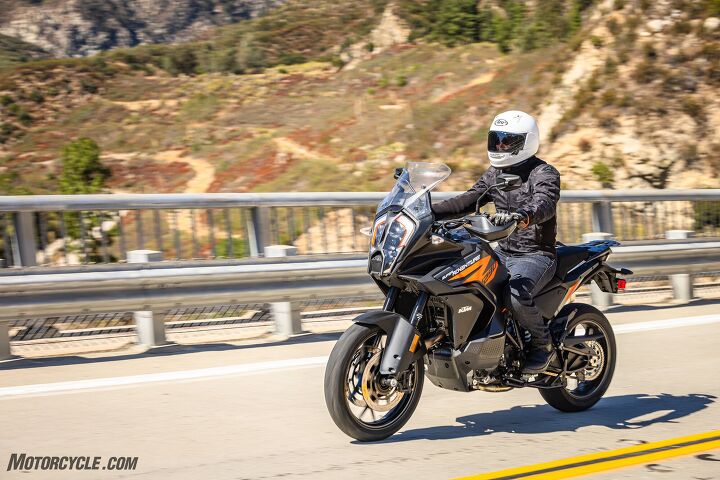

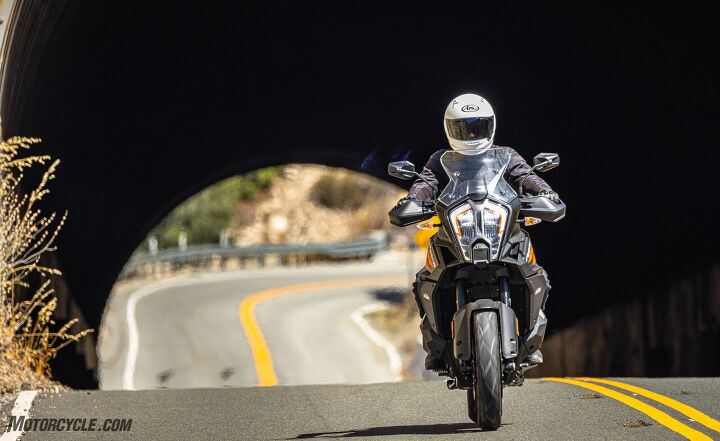

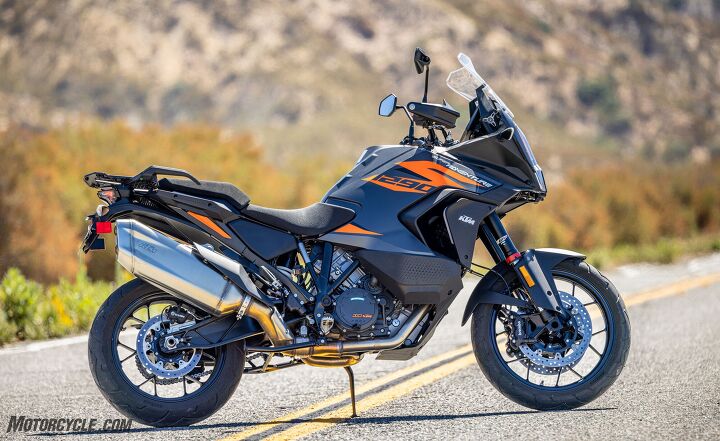
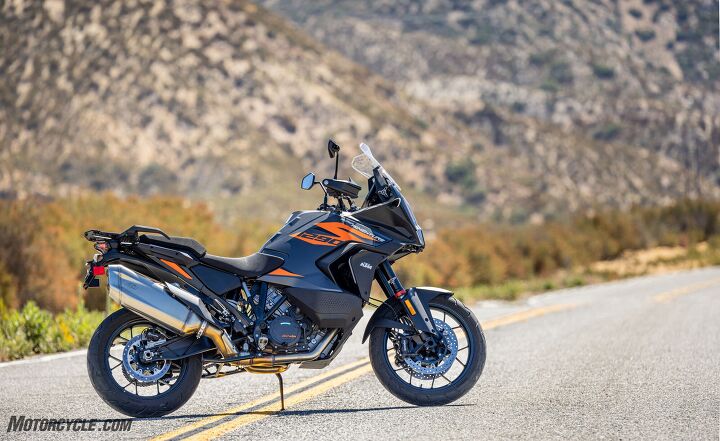

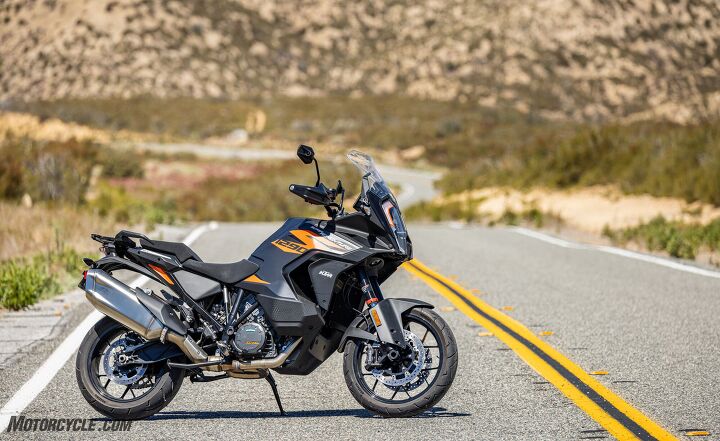
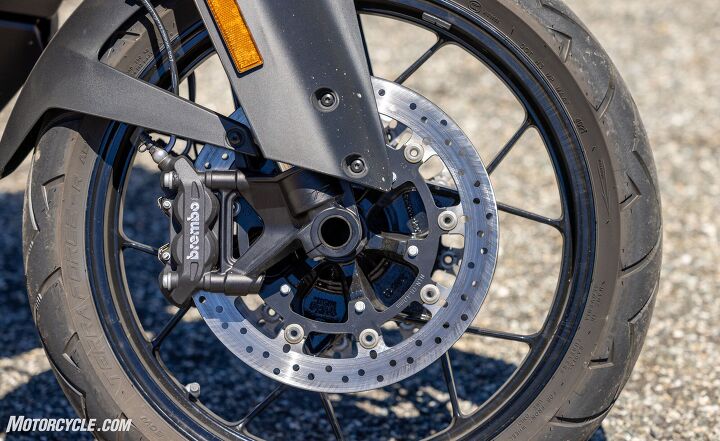


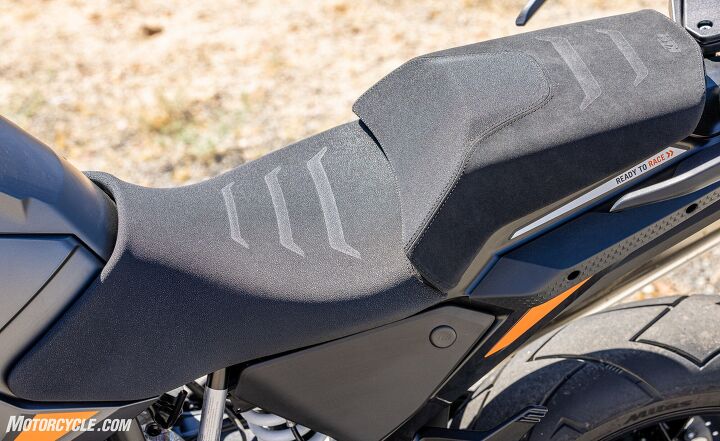

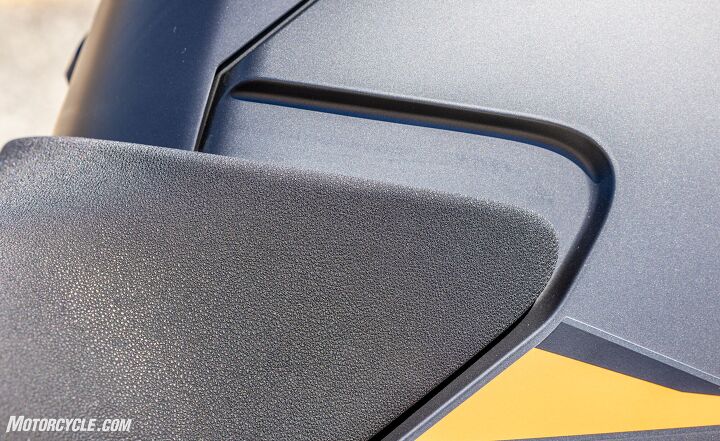

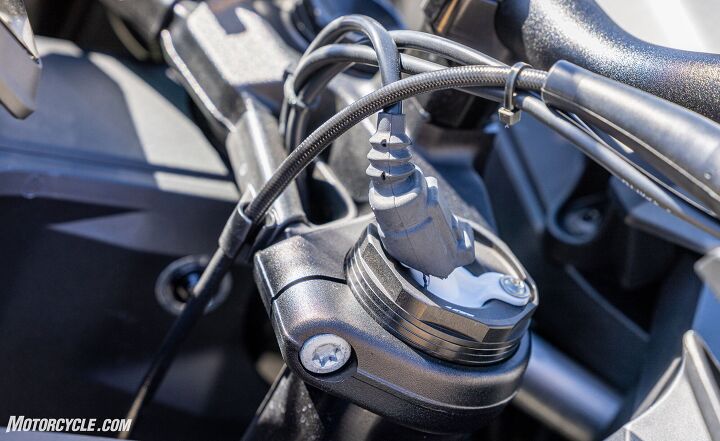
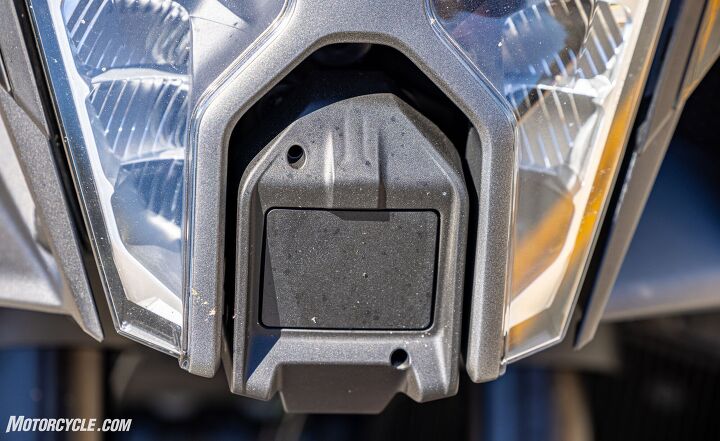

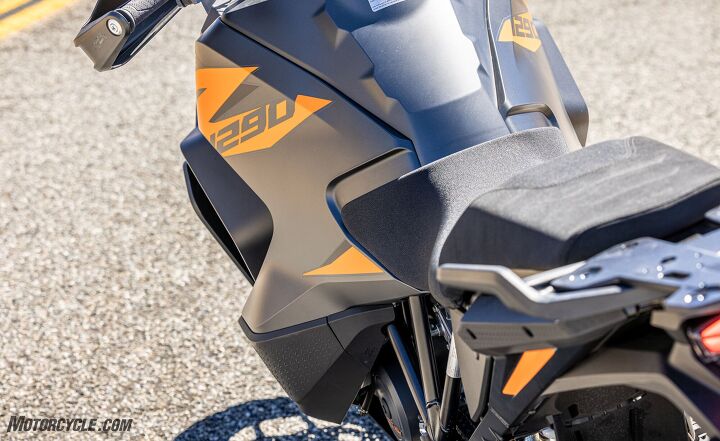

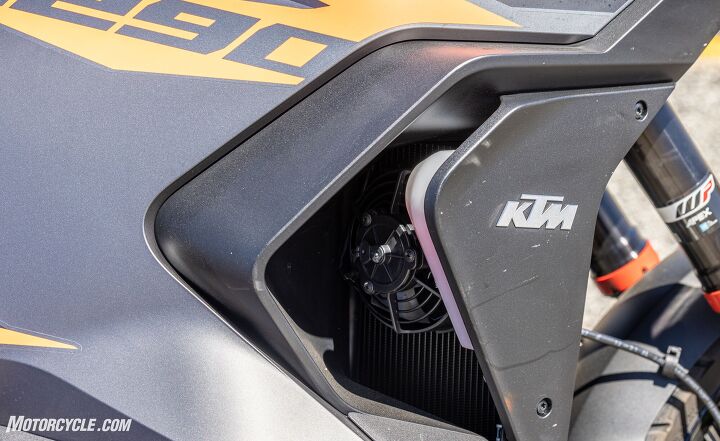
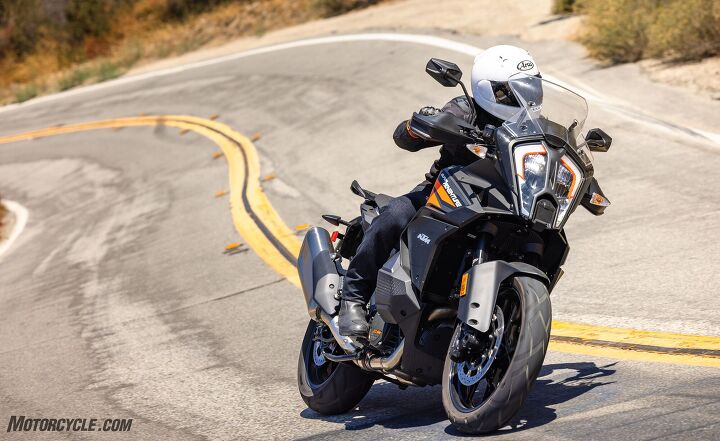
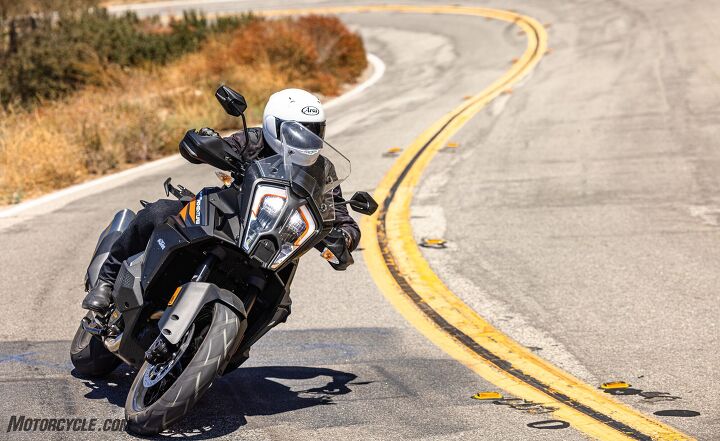

We are committed to finding, researching, and recommending the best products. We earn commissions from purchases you make using the retail links in our product reviews. Learn more about how this works.
Become a Motorcycle.com insider. Get the latest motorcycle news first by subscribing to our newsletter here.
The post 2022 KTM 1290 Super Adventure S – Mini Review appeared first on Motorcycle.com.
Copyright
© Motorcycle.com



